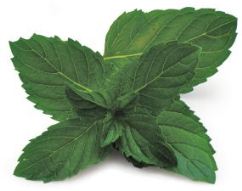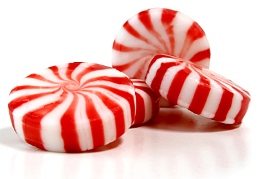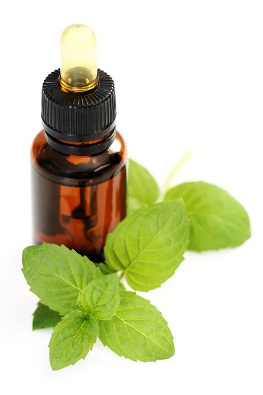
This is a natural hybrid of Mentha aquatica L. (water mint) and M.
spicata L. and is an easy growing perennial herb, growing up to 1 meter high, with underground runners and a distinctive menthol fragrance. Mentha (mint) is a genus of about 25 species (and many hundreds of varieties) of flowering plants in the family Lamiaceae (Mint Family). Species within Mentha have a subcosmopolitan distribution across Europe, Africa, Asia, Australia, and North America. Several mint hybrids commonly occur.
meter high, with underground runners and a distinctive menthol fragrance. Mentha (mint) is a genus of about 25 species (and many hundreds of varieties) of flowering plants in the family Lamiaceae (Mint Family). Species within Mentha have a subcosmopolitan distribution across Europe, Africa, Asia, Australia, and North America. Several mint hybrids commonly occur.
Mints are aromatic, almost exclusively perennial, rarely annual, herbs. They have wide-spreading underground rhizomes and erect, branched stems. The leaves are arranged in opposite pairs, from simple oblong to lanceolate, often downy, and with a serrated margin. Leaf colors range from dark green and gray-green to purple, blue and sometimes pale yellow. The flowers are produced in clusters ('verticils') on an erect spike, white to purple, the corolla two-lipped with four subequal lobes, the upper lobe usually the largest. The fruit is a small dry capsule containing one to four seeds.
While the species that make up the Mentha genus are widely distributed and can be found in many environments, many grow best in wet environments and moist soils. Mints will grow 10–120 cm tall and can spread over an indeterminate sized area. Due to the tendency to spread unchecked, mints are considered invasive.
Uses
Peppermint has a long tradition of medicinal use, with archaeological evidence placing its use at least as far back as ten thousand years ago. The most researched therapeutic activity of peppermint involves support of the digestive system. The oil exhibits very strong choleretic  activity, meaning it stimulates the liver and gall bladder to release bile (supporting digestive activity). The oil also inhibits muscle spasms in the intestines. Combined with its antibacterial effect, peppermint essential oil becomes a genuine medicine to help all sorts of digestion-related issues. It is said to relieve dyspepsia, nausea, stomach pains, and diarrhea. It is now commonly available in enteric coated capsules specifically for support of irritable bowel syndrome. For use at home, one can ingest 1 to 3 drops in a warm cup of water, or dilute in a carrier oil and massage into the abdomen (essential oils are absorbed though the skin, and can help the targeted organs in this manner).
activity, meaning it stimulates the liver and gall bladder to release bile (supporting digestive activity). The oil also inhibits muscle spasms in the intestines. Combined with its antibacterial effect, peppermint essential oil becomes a genuine medicine to help all sorts of digestion-related issues. It is said to relieve dyspepsia, nausea, stomach pains, and diarrhea. It is now commonly available in enteric coated capsules specifically for support of irritable bowel syndrome. For use at home, one can ingest 1 to 3 drops in a warm cup of water, or dilute in a carrier oil and massage into the abdomen (essential oils are absorbed though the skin, and can help the targeted organs in this manner).
Nutrient Content:The active constituents of Peppermint are primarily menthol and menthone. Peppermint also contains flavonoids, tannins, tocopherols, carotenes, B vitamins, calcium, potassium and other nutrients.
Peppermint has a high menthol content, and is often used as tea and for flavoring ice cream, confectionery, chewing gum, and toothpaste. The oil also contains menthone and menthyl esters, particularly menthyl acetate. Dried peppermint typically has 0.3-0.4% of volatile oil containing menthol (29-48%), menthone (20-31%), menthyl acetate (3-10%), menthofuran (1-7%) and many trace consituents including limonene, pulegone, eucalyptol, and pinene. It is the oldest and most popular flavor of mint-flavored confectionery. Peppermint can also be found in some shampoos and soaps, which give the hair a minty scent and produce a cooling sensation on the skin. Used in this way, it has been known to help with insomnia.
Peppermint has promising radioprotective effects for cancer patients undergoing cancer treatment.
The aroma of peppermint has been found to enhance memory. As such, it can be administered by instructors to their students before examinations, to aid recall.
Peppermint flowers are large nectar producers and honey bees as well as other nectar harvesting organisms forage them heavily. A mild, pleasant varietal honey can be produced if there is a sufficient area of plants.
Peppermint oil
Peppermint oil has a high concentration of natural pesticides, mainly menthone. In 2007, Italian investigators reported that 75% of the patients in their study who took peppermint oil capsules for four weeks had a major reduction in irritable bowel syndrome (IBS) symptoms, compared with just 38% of those who took a placebo. A second study in 2010, conducted in Iran, found similar results. 2011 research showed that peppermint acts through a specific anti-pain channel called TRPM8 to reduce pain sensing fibres. The authors feel that this study provides information that is potentially the first step in determining a new type of mainstream clinical treatment for Irritable Bowel Syndrome.
patients in their study who took peppermint oil capsules for four weeks had a major reduction in irritable bowel syndrome (IBS) symptoms, compared with just 38% of those who took a placebo. A second study in 2010, conducted in Iran, found similar results. 2011 research showed that peppermint acts through a specific anti-pain channel called TRPM8 to reduce pain sensing fibres. The authors feel that this study provides information that is potentially the first step in determining a new type of mainstream clinical treatment for Irritable Bowel Syndrome.
Similarly, some poorly designed earlier trials found that peppermint oil has the ability to reduce colicky abdominal pain due to IBS with an NNT (number needed to treat) around 3.1, but the oil is an irritant to the stomach in the quantity required and therefore needs wrapping for delayed release in the intestine. This could also be achieved by using the whole herb or leaves rather than the volatile components alone. Peppermint relaxes the gastro-esophageal sphincter, thus promoting belching.
How Should I Take Peppermint Oil?
How you take peppermint oil can make a world of difference.
In capsule form, it is much more effective to take it on an empty stomach, since the oil needs to pass through the stomach unimpeded and reach the intestines before it dissolves.
If you've eaten and have a full or partially-full stomach, the oil can be discharged too high up in your digestive system, and not give as much in the way of benefits.
Another way to ingest peppermint is through herbal tea. Peppermint tea is naturally caffeine-free and can be sweetened with a little honey or plain sugar.
Brew 1-2 tablespoons dried (or 3-4 tablespoons fresh) mint leaves per eight ounce cup of freshly-boiled water. You can also buy ready-made peppermint tea bags (I use two per mug, rather than one)
The stronger the tea, the better the effects on your digestion, so don't be afraid to make a dark brew!
Peppermint tea is an amazingly refreshing and invigorating drink, too, perfect for hot afternoons and evenings. Mint tea is common all over the Middle East, particularly after dinner.
Benefits:
Peppermint tea has long been used to help digestive complaints such as digestive cramps and spasms, flatulence, colic, and gallstones.
Peppermint can also help provide relief from low blood pressure or menstrual cramps.
Peppermint tea and oil is good for clearing the respiratory tract; it is an expectorant and thus, provides relief from respiratory problems like cough, cold, bronchitis, asthma, sinusitis, and nasal congestion.
Peppermint cream is an excellent topical ointment for relief of joint and muscle pain. You can also put 10 drops of oil into the bathtub for a relaxing experience.
Peppermint oil when use in aromatherapy can to help clear the mind, improves focusing power, and increases alertness.
Peppermint is also the only essential oil that can help cure both jet lag and motion sickness.
Peppermint essential oil is beneficial for toothache; just mix 3-5 drops in a cup of water and use it as your mouth wash. Do this before applying toothpaste if you're brushing your teeth.
Peppermint has also been shown to retard the growth of many varieties of bacteria and fungi.
Growing your own peppermint plants
For those who want to grow the peppermint herb at home, be aware of this: peppermint will take over your yard or garden quickly if you don’t contain it! Easy-to-grow peppermint plants generally do well in shaded areas and need a good water supply.
contain it! Easy-to-grow peppermint plants generally do well in shaded areas and need a good water supply.
As soon as the flowers begin to open, collect the leaves and flowering tops to use in your kitchen or medicine chest. Dry the leaves in a warm, dry place for at least a week to prevent mould from forming.
It’s best to use plants from a nursery or garden centre, as shop-bought peppermint plant seeds don’t always grow into true peppermint, but rather into a strangely-scented spearmint plant. True peppermint plants rarely produce seeds, because they are hybrid plants rather than originals, and therefore tend to be sterile.
Caution:
Peppermint should be avoided if you have cholecystitis (inflammation of the gallbladder) or severe liver disease.
Peppermint essential oil – the kinds that’s sold for aromatherapy – should be used with caution in people with asthma. Inhaling the fragrance of the essential oil could cause a flare-up of asthma.
Infants and children should avoid peppermint oil capsules, and adults should use peppermint essential oil in small doses to be effective.
Possible side effects include allergic reactions and heartburn - neither is particularly common, but anyone who suffers an adverse reaction should obviously steer clear of peppermint oil thereafter.
Be sure to avoid using this potent oil around eyes and nose to avoid burning sensitive skin.
![]()
Disclaimer: This website is for information purposes only. By providing the information contained herein we are not diagnosing, treating, curing, mitigating, or preventing any type of disease or medical condition. Before beginning any type of natural, integrative or conventional treatment regime, it is advisible to seek the advice of a licensed healthcare professional.



























